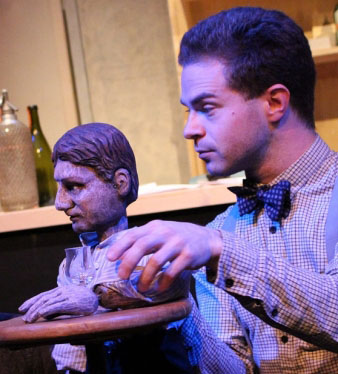
The last work of writer and journalist Joseph Roth before he died of alcoholism, The Legend is a painful yet magical autobiographical imagining from this eloquent liberal Jewish writer cast adrift in the late 1930s. Through Andreas, a wooden puppet, manipulated by two opportunist drinkers late one night in a Parisian bar, Roth paints a picture of a man who is haunted by loneliness and poverty, and acts as witness to a crumbling world that can, at the last, only be shut out by the oblivion of drink. Yet in the darkest hour his Andreas yearns for a sense of honour, strength of will and even religious redemption.
Against a beautifully constructed set constructed as a foldout Parisian bar, Gilbert Taylor acts as narrator (Roth) and puppeteer with his associate Kim Heron who also sings and plays the accordion. With the puppet Andreas the two weave his story before a charmed barmaid, Kate Malyon, whose own willing suspension of disbelief eventually leads her to dance with and feel empathy for the puppet and to express her own longings.
With trickery one suspects, the two drunks encourage the waitress, long past closing time, to part with her money ‘for the sake of the story’. Glasses are repeatedly filled, and Taylor becomes increasingly belligerent as the drink takes effect.
Roth gives us some poignant illustrations in the piece. From a man who has witnessed the fall of the Habsburg Empire and the rise of fascism in Germany, his life has been a trajectory of escape and backward longing. Our puppeteers and narrator explain Andreas’s experience walking alone through the city. He comes across a little girl who allows sand to pour through her fingers. A park attendant whispers in Andreas’s ear, “That is what life is like”. One can imagine Roth’s state of mind. In a letter to his friend and fellow Austrian Stefan Zweig he wrote, ‘You will have realised by now that we are drifting towards great catastrophes. Apart from the private – our literary and financial existence is destroyed – it all leads to a new war. I won’t bet a penny on our lives. They have succeeded in establishing a reign of barbarity. Do not fool yourself. Hell reigns.’
Towards the end, The Legend of the Holy Drinker taps into Roth’s attraction to Catholicism. In an extraordinary tableau scene, Malyon the waitress becomes a beaming Mary figure gazing down upon the prone figure of the dying Andreas.
Taylor, Heron and Malyon combine wonderfully to project this mystery play with real intensity. And in giving voice to Roth’s work they remind us that a rise of the far right across Europe still remains a threat 77 years after he wrote this piece. ★★★★☆ Simon Bishop 11th February 2016

